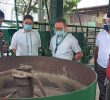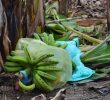�Using the cluster approach ensures the high quality of the produce, which is very crucial for institutional markets,� he said.
Gualberto added that by consolidating their produce, farmers in Southern Mindanao can take advantage of �economies of scale,� and consequently, negotiate higher prices for their produce.
�Our major concern really is how to improve the access of our small farmers to major markets,� he said. He believes however, that the region�s vegetable producers must undergo a �paradigm shift,� as they still need to fully appreciate the value of organizing themselves and adopting the cluster approach.
During the conference, Romulo Palcon, Regional Technical Director of the Department of Agriculture XI�s Regional Field Unit, urged farmers in the region to adapt Good Agriculture Practices (GAP) in vegetable farming.
GAP is a set of best farming practices that encompass all stages of the food production chain and conform to internationally-accepted standards for the production and export of fresh agricultural products.
GAP for vegetables focuses on the judicious use of agro-chemicals among growers, on workers� health and safety practices, and on appropriate harvest and post-harvest handling techniques.
Palcon said that being GAP-certified will enable farmers in Mindanao to significantly improve product quality and meet the ever-increasing demands of high-end institutional markets.
�Through GAP, we aim to transform our smallholder growers into successful entrepreneurs,� he said. Palcon stated that the DA is implementing several programs to help Mindanao farmers access key markets in the Luzon and Visayas.
For instance, the DA is opening more �food lanes� and �bagsakan centers� in Metro Manila in the agency�s bid to minimize layers in the marketing chain and increase the profits of Mindanao�s vegetable producers.
Palcon likewise encouraged farmers to set their sights on lucrative foreign markets such as Australia, which is now experiencing a shortage of vegetables due to a drought.
He added that China is also a promising market, which boasts of a per capita vegetable consumption of 250 kilograms, the highest in the world. (GEM)
Food









